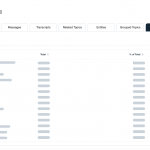7 Steps to CSR happiness
7 Steps to CSR happiness

Employee attrition can contribute to increased operating costs. Learn why it pays to focus on CSR’s (Customer Service Representatives) well-being using automated Workforce Management to inspire and motivate staff.
Good customer service depends on experienced and knowledgeable employees, yet failure to retain these talented employees can have significant repercussions. Recent research from global management consultants McKinsey reflects what Calabrio has suspected for a long time, that employee attrition can erode customer satisfaction while increasing operating costs. With each new customer service representative hire estimated to cost the contact center $10,000 to $20,000 in training, direct recruiting costs and lost productivity during ramp up, it pays to nurture your talent and keep them on side.
WFM: 7 steps to CSR employee happiness
The aim should be to create a connected wellness program including today’s modern Workforce Management (WFM) solutions.
Here are 7 ways you can work to increase CSR happiness in your contact center:
1. Introduce a culture that thrives on automation
Accentuate the direct, positive impact that automation has on employees such as transparency of processes and round-the-clock visibility of schedules. Focus on how WFM improves work/life balance with schedules that take into account agent skills and personal preferences and are well-communicated in advance. Consider involving employees when selecting new WFM technology. Look for a solution that is easy to learn, easy to use and factors in cultural and personal needs to its algorithms.
2. Your flexible friend
The latest statistics from YouGov in the UK claim the desire to work more flexibly was expressed by 70% of respondents, with 65% adding it would improve their well-being and satisfaction at work. Flexibility includes when, where and how employees work and different employment agreements to innovative Bring Your Own Device (BYOD) programs.
Rely on advanced WFM technology to balance, schedule and bring together a team of full-time, part-time, contract and virtual employees across a variety of fixed, split and micro-shifts cohesively while notifying flex workers of immediate needs and over-time opportunities as they occur.
3. Combat overwork and stress
Maximize the latest forecasting technology to right-size your contact center for the future. Running a series of ‘what if’ scenarios can predict staffing needs for regular seasonal fluctuations such as public holidays, upcoming new marketing campaigns and even your organization’s long-term business plan. Stop staff worrying about work if they or their colleagues suddenly fall ill or are called out on a family emergency by adding intra-day schedulers to the mix. Last-minute agent absences are no problem because break times, lunches and even the deployment of people between different skill groups can be accommodated in a matter of minutes.
4. Bring calm to chaos
Use WFM to schedule weekly huddles, group lunch n’ learns and training during quiet times so that agents can catch up with colleagues and strengthen their personal development in a relaxed environment away from the busy pressures of front-line duty. Don’t forget to build travel time into schedules to prevent employees from having to run from A to B. An extra 5 minutes is often all that’s needed to turn employees from frazzled to fabulous!
5. Give power to the employee
Give agents a greater sense of independence, involvement, and satisfaction by way of self-service options for preferred shifts, holiday requests and time off for medical appointments. Just be sure to respond in a timely manner to their requests – setting up auto-approvals means staff doesn’t have to wait till the next day for an answer should you be out of the office or on holiday yourself.
6. Think about infusing AI into the employee experience
Use chatbots that learn from existing data to help people manage their work-life balance. These bots can hold conversational chats to quickly notify staff of potential time off or overtime and create an easy balance between agent freedom and productivity.
7. Promote healthy competition and make learning fun
Make the most of advanced WFM reporting and dashboards to provide a real-time snapshot of agent and team performance against specific contact center KPIs or customer SLAs in a fair and transparent way. Next, introduce the latest gamification features to motivate agents, provide a forum for sharing top tips, encourage healthy competition and reward individual and team performance in a fun environment.









